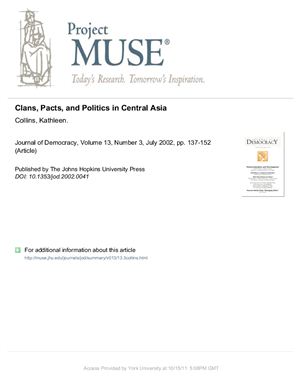Joual of Democracy, Volume 13, Number 3, July 2002, pp.
137-152
(Article)
Published by The Johns Hopkins University Press
DOI: 10.1353/jod.2002.0041
Central Asia is suddenly on the world map. Indeed, September 11 and
the U.S. war against the Taliban and the al-Qaeda terror network in Afghanistan
have drawn Central Asia from the periphery to near the center
of that map. Policy makers forging strategies for Afghanistan have begun
to realize that the entire vast region is plagued by increasingly weak
states and regimes that are losing popular legitimacy.The lapse of a decade since the breakup of the USSR finds the former Soviet Central Asian republics not more but actually
less stable, politically consolidated, prosperous, and free than they were
in 1991. Some or all could follow the disastrous path taken by Afghanistan
in the 1990s.
(Article)
Published by The Johns Hopkins University Press
DOI: 10.1353/jod.2002.0041
Central Asia is suddenly on the world map. Indeed, September 11 and
the U.S. war against the Taliban and the al-Qaeda terror network in Afghanistan
have drawn Central Asia from the periphery to near the center
of that map. Policy makers forging strategies for Afghanistan have begun
to realize that the entire vast region is plagued by increasingly weak
states and regimes that are losing popular legitimacy.The lapse of a decade since the breakup of the USSR finds the former Soviet Central Asian republics not more but actually
less stable, politically consolidated, prosperous, and free than they were
in 1991. Some or all could follow the disastrous path taken by Afghanistan
in the 1990s.

